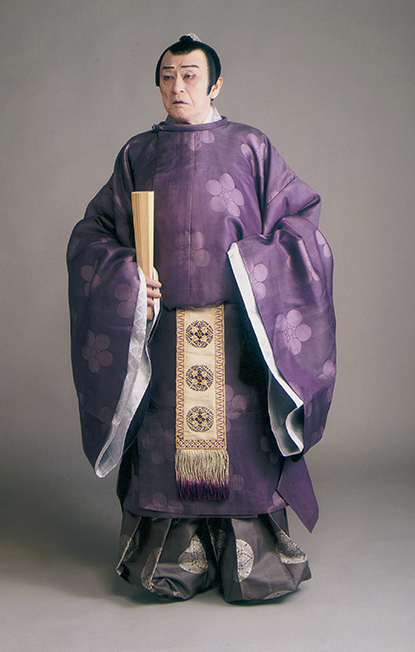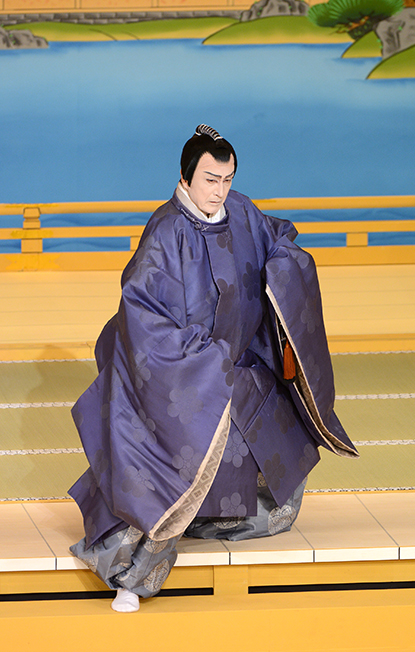松嶋屋についてAbout Matsushimaya

The “Matsushima-ya” Tradition―Passed on from Grandfather to Father, Father to Son―
Matsushima-ya, the family of Kataoka Nizaemon and one of the most prestigious kabuki families, spans fifteen generations. The first Nizaemon was a great actor, famous for his roles as villain, who enjoyed great popularity in Osaka during the Genroku period (1688-1704). Having disappeared for a while, the great name of Nizaemon rose to prominence again when Asao Kunigoro II took the name of Nizaemon VII in 1787. Nizaemon VIII was popular in Osaka, Kyoto and Edo (Tokyo) as a handsome male-role actor and his fourth son became Nizaemon XI, who is the father of Nizaemon XIII as well as the grandfather of the current Nizaemon.
Taking the name of Gato in the early Meiji Period, Nizaemon XI was a popular actor in the Kansai region, receiving acclaim alongside Nakamura Ganjiro I as a hanagata (star flower actor). He moved to Tokyo and took the name of Nizaemon XI in 1907. He had many successful roles in a variety of schools such as Gidayu Kabuki, Shin Kabuki and Wagoto Kyogen. He was also a man of great learning and passed on a new acting training system to his son, who later became Nizaemon XIII. Nizaomon XI’s unique method entailed creating a character according to a playbook.
Nizaemon XIII was born in Tokyo and became the leader of the nascent Seinen Kabuki school in 1932. Whenever he took on a new role, Nizaemon XIII invited specialists to conduct study meetings focused on playbook (joruri) music and acting style and production (kata). He also asked senior actors, such as Nizaemon XI, known for playing a particular role, to give him instruction. Seinen Kabuki was dissolved in 1939 and Nizaemon XIII moved back to Kansai Kabuki.
Osaka is the hometown of the Kataoka family, where the current Nizaemon appeared on stage several times during his hanagata period. The traditional art of Matsushima-ya includes many Kamigata Kyogen plays. Nizaemon XIII played in many of them and acquired the acting style and production of both Edo (Tokyo) and Kamigata (Osaka/Kyoto).
Kansai Kabuki lost popularity in the mid-Showa period (1955-1964) and faced a crisis. Nizaemon XIII could have moved back to his hometown, Tokyo, but he decided to stay in Osaka and endeavored to save the tradition of Kamigata Kabuki by investing his own money in the establishment of the Nizaemon Kabuki school, which later lead to the renaissance of Kamigata Kabuki.
 『菅原伝授手習鑑~道明寺』昭和63年2月歌舞伎座
『菅原伝授手習鑑~道明寺』昭和63年2月歌舞伎座菅丞相(十三代目片岡仁左衛門) ©松竹(株)
 『菅原伝授手習鑑~道明寺』平成27年3月歌舞伎座
『菅原伝授手習鑑~道明寺』平成27年3月歌舞伎座菅丞相(十五代目片岡仁左衛門) ©松竹(株)
The kata (style) of kabuki in Edo Kabuki is manifest in Aragoto (rough style) roles such as those in Shibaraku or Kanjincho. In Aragoto, from striking the mie (emotional pose) to using the technique roppo (the exaggerated expression of walking), the style is the same for all actors. However, in Kamigata Kyogen, each family has their own playbooks and styles of acting, as in Kuruwa Bunsho or Fuin-giri. Traditionally, Kamigata Kyogen values the actor’s unique acting style and technique.
The teaching method of Nizaemon XI enshrines the above tradition of Kamigata Kabuki, which Nizaemon XIII also tried to follow in his creation of characters. One of his most successful roles was Kanshojo in Sugawara Denju Tenarai Kagami. He created his own version of Kanshojo by studying his father’s depiction and adding elements of the way of Ganjiro I. As the creator of the Matsushima-ya style, Nizaemon XIII added humor to the first half of Kuruwa Bunsho with his rendition of Izaemon, transforming the play into a more brilliant production.
The current Nizaemon has kept training assiduously in his father’s discipline. In his youth, he struggled due to the economic slump of Kansai Kabuki, but he eventually drew attention playing Yohei in Onna Goroshi Abura no Jigoku and Yoshikata in Yoshikata Saigo. He came to Tokyo and flourished alongside celebrated onnagata actor Bando Tamasaburo in hanagata kabuki. He created his own interpretation of the Yohei and Yoshikata roles by referring to the acting style and techniques of other senior actors.
Although he continues to play these roles with the same attitude and spirit, the current Nizaemon also values the style that has been passed on by the Matsushima-ya family. However, he doesn’t simply passively follow the Matsushima-ya style, but challenges it by creating new characters. For example, in two of his most successful roles, Gonta in Senbon Zakura and Kumagai in Kumagai Jinya, he creates his own acting style. Outside of Kamigata Kyogen, he has also been successful in the genres of Nanboku-mono, Mokuami-mono and Kabuki Juhachiban, the Eighteen Best Kabuki Plays, performing roles including Benkei in Kanjin-cho and Sukeroku. His success in a variety of roles and genres is thanks to his continuing commitment to study and the creation of roles, as well as his natural good looks and voice.
While he respects the traditional staging and acting styles that have been passed down through the history of kabuki, the current Nizaemon cherishes “spirit” above all, a quality that has been inherited by his eldest son, Takataro and his grandson, Sennosuke.
Honoring these principles on the stage, the three generations of Matsushima-ya hope people will continue to enjoy and support kabuki for many years to come.

